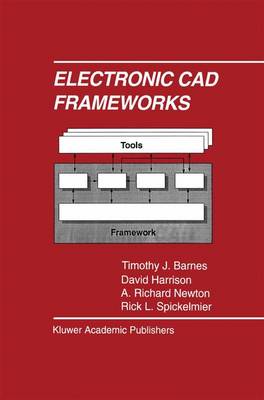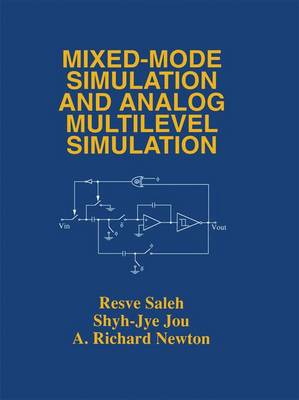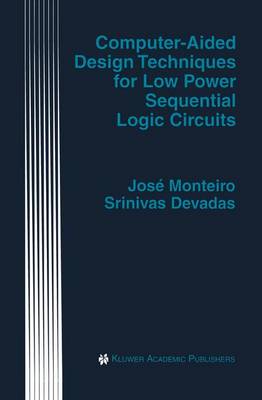The Springer International Series in Engineering and Computer Science
6 primary works
Book 98
Our purpose in writing this book was two-fold. First, we wanted to compile a chronology of the research in the field of mixed-mode simulation over the last ten to fifteen years. A substantial amount of work was done during this period of time but most of it was published in archival form in Masters theses and Ph. D. dissertations. Since the interest in mixed-mode simulation is growing, and a thorough review of the state-of-the-art in the area was not readily available, we thought it appropriate to publish the information in the form of a book. Secondly, we wanted to provide enough information to the reader so that a proto type mixed-mode simulator could be developed using the algorithms in this book. The SPLICE family of programs is based on the algorithms and techniques described in this book and so it can also serve as docu mentation for these programs. ACKNOWLEDGEMENTS The authors would like to dedicate this book to Prof. D. O. Peder son for inspiring this research work and for providing many years of support and encouragement The authors enjoyed many fruitful discus sions and collaborations with Jim Kleckner, Young Kim, Alberto Sangiovanni-Vincentelli, and Jacob White, and we thank them for their contributions. We also thank the countless others who participated in the research work and read early versions of this book. Lillian Beck provided many useful suggestions to improve the manuscript. Yun cheng Ju did the artwork for the illustrations.
Book 162
Sequential Logic Synthesis
by Pranav Ashar, S. Devadas, and A. Richard Newton
Published 30 November 1991
3. 2 Input Encoding Targeting Two-Level Logic . . . . . . . . 27 3. 2. 1 One-Hot Coding and Multiple-Valued Minimization 28 3. 2. 2 Input Constraints and Face Embedding 30 3. 3 Satisfying Encoding Constraints . . . . . . . 32 3. 3. 1 Definitions . . . . . . . . . . . . . . . 32 3. 3. 2 Column-Based Constraint Satisfaction 33 3. 3. 3 Row-Based Constraint Satisfaction . . 37 3. 3. 4 Constraint Satisfaction Using Dichotomies . 38 3. 3. 5 Simulated Annealing for Constraint Satisfaction 41 3. 4 Input Encoding Targeting Multilevel Logic. . 43 3. 4. 1 Kernels and Kernel Intersections . . . 44 3. 4. 2 Kernels and Multiple-Valued Variables 46 3. 4. 3 Multiple-Valued Factorization. . . . . 48 3. 4. 4 Size Estimation in Algebraic Decomposition . 53 3. 4. 5 The Encoding Step . 54 3. 5 Conclusion . . . . . . . . . 55 4 Encoding of Symbolic Outputs 57 4. 1 Heuristic Output Encoding Targeting Two-Level Logic. 59 4. 1. 1 Dominance Relations. . . . . . . . . . . . . . . . 59 4. 1. 2 Output Encoding by the Derivation of Dominance Relations . . . . . . . . . . . . . . . . . . . . . 60 . . 4. 1. 3 Heuristics to Minimize the Number of Encoding Bits . . . . . . . . . . . . 64 4. 1. 4 Disjunctive Relationships . . . . . . . . . . . 65 4. 1. 5 Summary . . . . . . . . . . . . . . . . . . 66 . . 4. 2 Exact Output Encoding Targeting Two-Level Logic. 66 4. 2. 1 Generation of Generalized Prime Implicants . 68 4. 2. 2 Selecting a Minimum Encodeable Cover . . . 68 4. 2. 3 Dominance and Disjunctive Relationships to S- isfy Constraints . . . . . . . . . . . 70 4. 2. 4 Constructing the Optimized Cover 73 4. 2. 5 Correctness of the Procedure . . 73 4. 2. 6 Multiple Symbolic Outputs . . .
Book 163
Sequential Logic Testing and Verification
by Abhijit Ghosh, Srinivas Devadas, and A. Richard Newton
Published 30 November 1991
In order to design and build computers that achieve and sustain high performance, it is essential that reliability issues be considered care fully. The problem has several aspects. Certainly, considering reliability implies that an engineer must be able to analyze how design decisions affect the incidence of failure. For instance, in order design reliable inte gritted circuits, it is necessary to analyze how decisions regarding design rules affect the yield, i.e., the percentage of functional chips obtained by the manufacturing process. Of equal importance in producing reliable computers is the detection of failures in its Very Large Scale Integrated (VLSI) circuit components, caused by errors in the design specification, implementation, or manufacturing processes. Design verification involves the checking of the specification of a design for correctness prior to carrying out an implementation. Implementation verification ensures that the manual design or automatic synthesis process is correct, i.e., the mask-level description correctly implements the specification. Manufacture test involves the checking of the complex fabrication process for correctness, i.e., ensuring that there are no manufacturing defects in the integrated circuit. It should be noted that all the above verification mechanisms deal not only with verifying the functionality of the integrated circuit but also its performance.
Book 185
Electronic CAD Frameworks
by Timothy J. Barnes, David Harrison, A. Richard Newton, and Rick L. Spickelmier
Published 30 June 1992
When it comes to frameworks, the familiar story of the elephant and the six blind philosophers seems to apply. As each philoso pher encountered a separate part of the elephant, each pronounced his considered, but flawed judgement. One blind philosopher felt a leg and thought it a tree. Another felt the tail and thought he held a rope. Another felt the elephant's flank and thought he stood before a wall. We're supposed to learn about snap judgements from this alle gory, but its author might well have been describing design automation frameworks. For in the reality of today's product development requirements, a framework must be many things to many people. xiv CAD Frameworks: Integration Technology for CAD As the authors of this book note, framework design is an optimi zation problem. Somehow, it has to be both a superior rope for one and a tremendous tree for another. Somehow it needs to provide a standard environment for exploiting the full potential of computer-aided engineering tools. And, somehow, it has to make real such abstractions as interoperability and interchangeability. For years, we've talked about a framework as something that provides application-oriented services, just as an operating system provides system-level support. And for years, that simple statement has hid the tremendous complexity of actually providing those services.
Book 279
Mixed-Mode Simulation and Analog Multilevel Simulation
by Resve A. Saleh, Shyh-Jye Jou, and A. Richard Newton
Published 31 August 1994
Mixed-Mode Simulation and Analog Multilevel Simulation addresses the problems of simulating entire mixed analog/digital systems in the time-domain. A complete hierarchy of modeling and simulation methods for analog and digital circuits is described.
Mixed-Mode Simulation and Analog Multilevel Simulation also provides a chronology of the research in the field of mixed-mode simulation and analog multilevel simulation over the last ten to fifteen years. In addition, it provides enough information to the reader so that a prototype mixed-mode simulator could be developed using the algorithms in this book.
Mixed-Mode Simulation and Analog Multilevel Simulation can also be used as documentation for the SPLICE family of mixed-mode programs as they are based on the algorithms and techniques described in this book.
Mixed-Mode Simulation and Analog Multilevel Simulation also provides a chronology of the research in the field of mixed-mode simulation and analog multilevel simulation over the last ten to fifteen years. In addition, it provides enough information to the reader so that a prototype mixed-mode simulator could be developed using the algorithms in this book.
Mixed-Mode Simulation and Analog Multilevel Simulation can also be used as documentation for the SPLICE family of mixed-mode programs as they are based on the algorithms and techniques described in this book.
Book 387
Computer-Aided Design Techniques for Low Power Sequential Logic Circuits
by Jose Monteiro and Srinivas Devadas
Published 30 November 1996
Rapid increases in chip complexity, increasingly faster clocks, and the proliferation of portable devices have combined to make power dissipation an important design parameter. The power consumption of a digital system determines its heat dissipation as well as battery life. For some systems, power has become the most critical design constraint.
Computer-Aided Design Techniques for Low Power Sequential Logic Circuits presents a methodology for low power design. The authors first present a survey of techniques for estimating the average power dissipation of a logic circuit. At the logic level, power dissipation is directly related to average switching activity. A symbolic simulation method that accurately computes the average switching activity in logic circuits is then described. This method is extended to handle sequential logic circuits by modeling correlation in time and by calculating the probabilities of present state lines.
Computer-Aided Design Techniques for Low Power Sequential Logic Circuits then presents a survey of methods to optimize logic circuits for low power dissipation which target reduced switching activity. A method to retime a sequential logic circuit where registers are repositioned such that the overall glitching in the circuit is minimized is also described. The authors then detail a powerful optimization method that is based on selectively precomputing the output logic values of a circuit one clock cycle before they are required, and using the precomputed value to reduce internal switching activity in the succeeding clock cycle.
Presented next is a survey of methods that reduce switching activity in circuits described at the register-transfer and behavioral levels. Also described is a scheduling algorithm that reduces power dissipation by maximising the inactivity period of the modules in a given circuit.
Computer-Aided Design Techniques for Low Power Sequential Logic Circuits concludes with a summary and directions for future research.
Computer-Aided Design Techniques for Low Power Sequential Logic Circuits presents a methodology for low power design. The authors first present a survey of techniques for estimating the average power dissipation of a logic circuit. At the logic level, power dissipation is directly related to average switching activity. A symbolic simulation method that accurately computes the average switching activity in logic circuits is then described. This method is extended to handle sequential logic circuits by modeling correlation in time and by calculating the probabilities of present state lines.
Computer-Aided Design Techniques for Low Power Sequential Logic Circuits then presents a survey of methods to optimize logic circuits for low power dissipation which target reduced switching activity. A method to retime a sequential logic circuit where registers are repositioned such that the overall glitching in the circuit is minimized is also described. The authors then detail a powerful optimization method that is based on selectively precomputing the output logic values of a circuit one clock cycle before they are required, and using the precomputed value to reduce internal switching activity in the succeeding clock cycle.
Presented next is a survey of methods that reduce switching activity in circuits described at the register-transfer and behavioral levels. Also described is a scheduling algorithm that reduces power dissipation by maximising the inactivity period of the modules in a given circuit.
Computer-Aided Design Techniques for Low Power Sequential Logic Circuits concludes with a summary and directions for future research.





